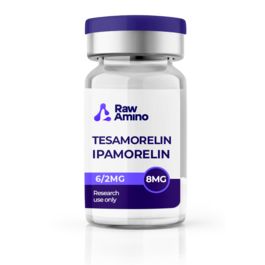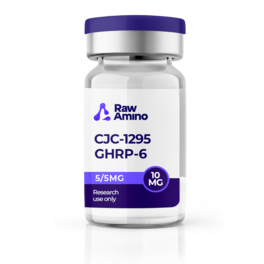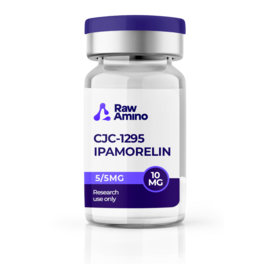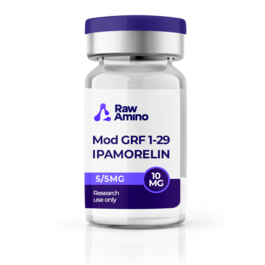
CJC-1295 (Mod GRF 1-29) & Ipamorelin & GHRP-2 – 9MG
$87.00
Discount per Quantity
| Quantity | Discount | Price |
|---|---|---|
| 5 - 8 | 5% | $82.65 |
| 9 + | 10% | $78.30 |
Scientific Overview of CJC-1295 & Ipamorelin & GHRP-2 Peptide Blend
The combination of CJC-1295 & Ipamorelin & GHRP-2 represents a peptide blend that has been widely investigated in the context of growth hormone modulation. Each peptide belongs to the class of Growth Hormone Secretagogues (GHS), with overlapping but distinct mechanisms that may collectively enhance Growth Hormone (GH) release, Insulin-Like Growth Factor 1 (IGF-1) expression, and downstream anabolic processes.
CJC-1295 (Mod GRF 1-29): A synthetic analog of GHRH (1-29), designed for improved pharmacokinetics. Studies suggest it may raise GH levels by 200–1000% and increase mean plasma IGF-1 concentrations by 1.5–3 fold, with effects persisting for 6–8 days under experimental conditions .
Ipamorelin: A selective pentapeptide GHS that mimics ghrelin activity. It appears to selectively stimulate GH release without affecting cortisol, prolactin, or aldosterone .
GHRP-2: A second-generation GHS that may enhance GH secretion by amplifying the GHRH pathway and suppressing somatostatin signaling. It has also been observed to increase appetite and modulate oxidative stress responses .
CJC-1295 & Ipamorelin & GHRP-2 Studies and Research Data
Muscle Mass and Tissue Growth
The blend has been studied in the context of cellular proliferation, tissue repair, and lean body mass. In GHRH knockout murine models, CJC-1295 administered daily was associated with normalization of body weight, bone growth (femur, tibia), and pituitary GH mRNA levels. Findings suggested a proliferative effect on somatotroph cells, though less frequent administration reduced these outcomes .
Bone Density
Ipamorelin and related secretagogues have been evaluated in murine models for their influence on bone mineral content (BMC). Observations indicated increases in cortical BMC and total bone volume, likely due to enhanced bone dimensions rather than volumetric mineral density changes. These findings point to possible GH-mediated activity on osteoblast proliferation and differentiation .
Cell Aging and Oxidative Stress
Declining GH levels are a hallmark of aging. Research into this blend has proposed potential roles in countering age-related degeneration, supporting collagen synthesis, and reducing oxidative damage. GHRP-2, in particular, has been studied for antioxidative effects. In murine ApoE(-/-) models, GHRP-2 was associated with elevated IGF-1 levels, reduced interferon-gamma, decreased superoxide production, and modulation of inflammatory gene expression . These findings suggest possible protective mechanisms against oxidative stress and apoptosis in vascular and macrophage cells.
CJC-1295 & Ipamorelin & GHRP-2: Additional Research Directions
Further studies on this peptide combination have explored:
-Cardiovascular resilience and recovery following ischemic events.
-Tissue repair and recovery following laboratory-induced injury.
-Immunomodulation and inflammatory response.
-Cognitive and neuroprotective effects in degenerative models.
-Regulation of circadian rhythms and sleep cycles.
Conclusion
The synergistic use of CJC-1295 (Mod GRF 1-29), Ipamorelin, and GHRP-2 has been studied for its combined potential in enhancing growth hormone release, influencing bone and muscle physiology, countering oxidative stress, and supporting regenerative processes. While results in experimental models are promising, research remains preliminary, and findings are not yet conclusive for translational outcomes.
References
- Teichman, S. L., et al. (2006). J Clin Endocrinol Metab, 91(3), 799–805. https://doi.org/10.1210/jc.2005-1536
- Raun, K., et al. (1998). Eur J Endocrinol, 139(5), 552–561. https://doi.org/10.1530/eje.0.1390552
- Laferrère, B., et al. (2005). J Clin Endocrinol Metab, 90(2), 611–614. https://doi.org/10.1210/jc.2004-1719
- Alba, M., et al. (2006). Am J Physiol Endocrinol Metab, 291(6), E1290–E1294. https://doi.org/10.1152/ajpendo.00201.2006
- Svensson, J., et al. (2000). J Endocrinol, 165(3), 569–577. https://doi.org/10.1677/joe.0.1650569
- Titterington, J. S., et al. (2009). Endocrinology, 150(12), 5478–5487. https://doi.org/10.1210/en.2009-0283
Disclaimer:
The products mentioned are intended solely for laboratory research and in-vitro experimentation. They are not approved for human or animal use of any kind. All details provided are for educational purposes only. By purchasing from this site, you agree to comply with our Terms and Conditions.
Only logged in customers may leave a review.





Reviews
There are no reviews yet.